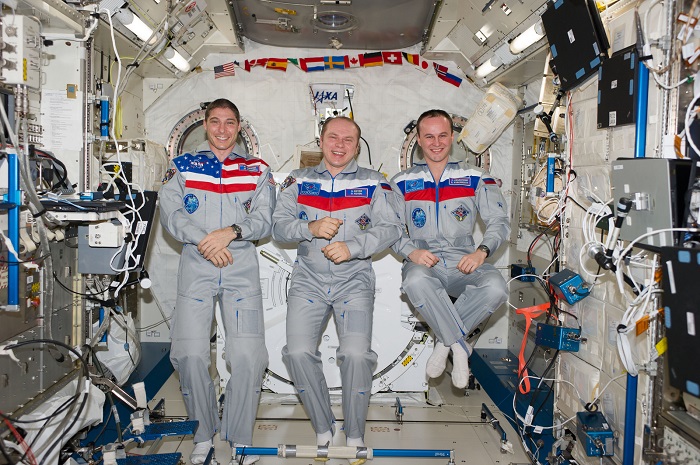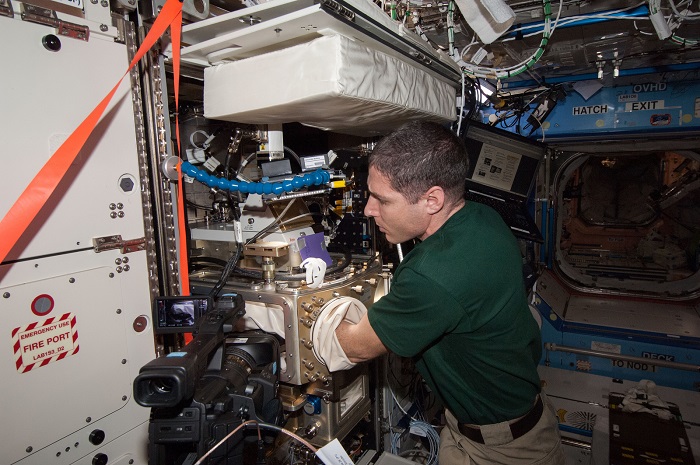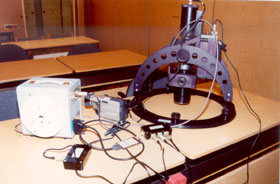.
The International Space Station completed this week’s deployment of the NanoRacks CubeSats. The six-member Expedition 38 crew also worked on various science activities and prepared for a March 10 Soyuz undocking.
The final set of CubeSats, used for Earth observations, were released from the Kibo laboratory’s Multi-Purpose Experiment Platform (MPEP) Friday at 2:30 a.m. EST. Japanese flight controllers then guided the Japanese robotic arm to place the MPEP back inside Kibo’s airlock. The airlock was then repressurized wrapping up the micro-satellite deployment activities.
.

Expedition 37/38 crew members (from left) Mike Hopkins, Oleg Kotov and Sergey Ryazanskiy are preparing to return to Earth inside their Soyuz TMA-10M spacecraft March 10.
.
Japanese astronaut Koichi Wakata worked on an internal robotics project partnering with NASA astronaut Rick Mastracchio. The duo participated in the SPHERES-SLOSH experiment using tiny satellites to study how fluids behave inside a container in microgravity. The tiny satellites, also known as SPHERES, may provide advances for rocket fuel delivery systems.
Wakata also had time set aside Friday morning for work with the Aniso Tubule plant experiment. He retrieved experiment samples and set them up for microscopic observation.
Flight Engineer Mike Hopkins opened the Fluids Integrated Rack inside the Destiny laboratory for some maintenance work. He temporarily removed an optics bench in the rack to replace an avionics package and a white light lamp. Hopkins later joined Mastracchio for a live question and answer session with students from Osage Beach, Mo.
.

Astronaut Mike Hopkins works inside the Light Microscopy Module which is part of the Destiny laboratory's Fluids Integrated Rack.
.
Commander Oleg Kotov and Flight Engineer Sergey Ryazanskiy teamed up to prepack gear for their upcoming return to Earth. Hopkins will join them for the ride home on March 10, officially ending Expedition 38. In preparation for the departure Kotov on March 9 will ceremonially handover command to Wakata, who will become the first Japanese station commander.
Veteran cosmonaut Mikhail Tyurin photographed the conditions of the windows inside the Station’s Russian segment. He also monitored the reaction of jet and propulsion system exhaust on the Earth’s upper atmosphere and the space station’s external environment for the Relaxation experiment.

Objective:
Investigation of chemiluminescent chemical reactions and atmospheric optical phenomena occurring during high-speed interaction between jet engine exhausts and the Earth's upper atmosphere, atmospheric optical phenomena during re-entry of bodies into rarified upper atmosphere and its optical properties in the UV range.
Tasks:
Conducting radiometric and spectrometric measurements in the UV range:
- Radiation emitted in reactions of interaction between ISS RS propulsion system exhaust products and atomic oxygen;
- Radiation emitted in reactions of interaction of Soyuz and Progress propulsion system exhaust products during undocking maneuvers, retroburns and re-entry into the Earth's upper atmosphere;
- Spacial distribution and emission spectra of atmospheric formations and phenomena.
Science Hardware Used:
"Fialka-MV-Kosmos multispectral UV system which includes
- UV camera
- Spectrometer
- Video camera
- A set of interference filters
Consumables:
- Mini-DV video tapes
- Diskettes
Expected Results:
Determining the effects of propulsion system exhausts on the Earth upper atmosphere and ISS environment, on optically sensitive surfaces (windows, equipment lenses, solar array panels). In perspective, simulation of atmospheric optical phenomena in ultra-violet, visible and near-infrared spectral bands (Earth atmosphere nightglow, SC re-entry glow, planetary atmospheric glow).
.
Waiting to replace the returning astronauts are Expedition 39/40 crew members Steve Swanson, Alexander Skvortsov and Oleg Artemyev. The trio is in Star City, Russia, conducting suited dress rehearsals inside a Soyuz simulator. They are scheduled to launch aboard a Soyuz TMA-12 Soyuz spacecraft on March 25 for a six-hour ride to the station’s Poisk mini-research module for a docking.
.
Quelle: NASA
